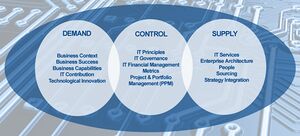Gartner's IT Strategy Model
What is Gartner's IT Strategy Model?
Gartner's IT strategy model is a framework for developing and implementing effective information technology (IT) strategies in organizations. The model was developed by the Gartner Group, a research, and advisory company that specializes in IT.
The model consists of four phases:
- Assess: In this phase, the organization assesses its current IT capabilities and identifies areas for improvement. This involves gathering data on the organization's IT assets, processes, and stakeholders.
- Plan: In this phase, the organization develops a plan for improving its IT capabilities. This may include setting goals and objectives, identifying resources and budgets, and developing a roadmap for implementation.
- Implement: In this phase, the organization puts the technology Strategy into action by implementing the planned changes and measures to ensure that they are successful.
- Review and adjust: In this phase, the organization reviews the results of the implemented IT strategy and makes any necessary adjustments. This may involve gathering feedback from stakeholders and adjusting the plan as needed.
Source: Ivan Snell
The Gartner IT strategy model is designed to help organizations develop and implement effective IT strategies that align with their overall business goals and objectives. It is a useful tool for organizations of all sizes and industries, providing a structured approach to improving IT capabilities and staying competitive in the digital landscape.
See Also
- IT Strategy Framework
- Business IT Alignment: Ensuring that IT strategies are closely aligned with the overall business goals and objectives of the organization. This involves understanding the business context, identifying IT opportunities and challenges, and prioritizing IT investments to support business priorities.
- IT Strategic Planning: Developing a strategic plan that defines the organization's IT vision, goals, and priorities over a defined time horizon. This includes conducting a situational analysis, setting strategic objectives, and developing action plans to achieve strategic goals.
- Technology Assessment: Assessing current and emerging technologies to determine their potential impact on the organization's IT strategy. This involves evaluating technology trends, conducting technology assessments, and identifying opportunities to leverage technology for business innovation and competitive advantage.
- Risk Management: Identifying and managing risks associated with IT investments and initiatives to ensure that they align with the organization's risk appetite and tolerance. This includes assessing cybersecurity, compliance, and operational risks and other risks that may impact the organization's IT strategy.
- Governance and Performance Management: Establishing governance processes and performance metrics to monitor and evaluate the effectiveness of the organization's IT strategy. This involves defining roles and responsibilities, establishing decision-making frameworks, and implementing performance measurement systems to track progress and ensure accountability.

